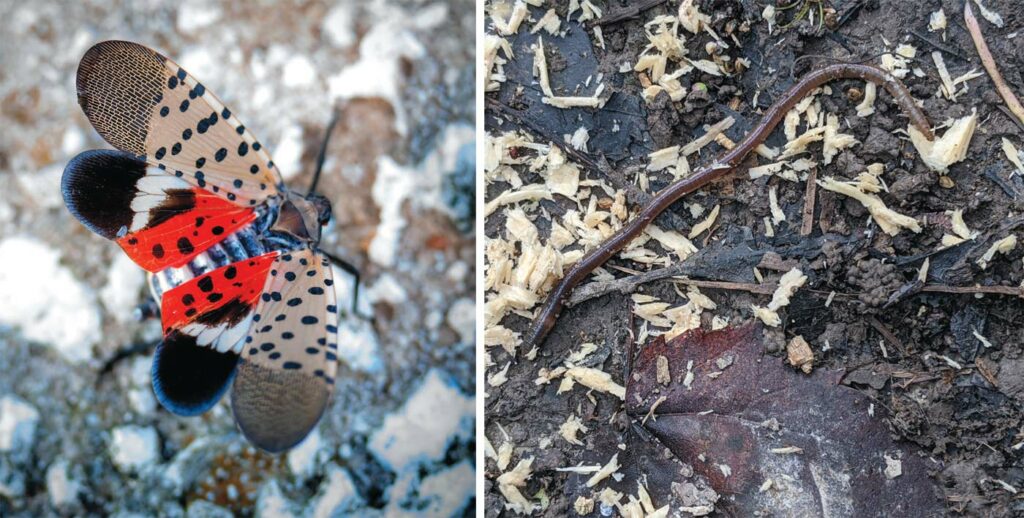Watch Out for These Pests in Your Garden and Home Orchard

Most gardeners know a handful of garden interlopers: aphids, slugs, Japanese beetles, etc. I’d like to introduce you to three less-familiar pests that pose challenges you’ll likely face very soon.
SPONGY MOTH
Lymantria dispar dispar
By now you’ve learned the hard way about this critter’s capacity to eat leaves. If you have apples (and/or crabapples), you know they love to eat the leaves of these trees, causing the tree great stress and ruining numerous crops. Over the last couple of years, they also did a lot of damage to blueberries and many shade trees, including their favorite: oaks. That could mean fewer acorns and less food for deer and squirrels.
The insect has been ever-present since its accidental introduction to the U.S. in 1869, but occasional intense outbreaks of this pest, such as the one that began in our area two years ago, have been particularly damaging.
A fungus called Entomophaga maimaiga helps kill the caterpillars in the spring, but it requires moisture to do its thing. We had very dry springs in 2021 and 2022 in the Berkshires, giving spongy moth a leg up.
What you can do: Watch for the adult moths, ID them properly, and squash away. Watch for the ovate, mounded, soft, and “spongy” egg masses on just about any surface. Rub them into soapy water and let sit overnight to smother them. Come next winter, we’ll start to have a much better idea as to whether they’ll be back for more in 2024.

SPOTTED LANTERNFLY
Lycorma delicatula
It’s only a matter of time before this voracious insect pest becomes a household name. Unfortunately, the spotted lanternfly seems to love eating a lot of things that we love to eat—apples, peaches, plums, cherries, peaches, apricots, and of particular concern: grapes.
Please take a second to look up the features of the [beautiful] moth and its life stages. Both the immature stages and the adult will feed on plants, depriving the host of nutrition and weakening the plant. The egg masses are distinctive and can show up on just about any surface.
You’ll likely see flocks of these insects within a few years, along with the black honeydew (bug poop) they leave behind.
Meanwhile, watch for those eggs and destroy them; watch for adults and smash them. And, until further notice, please report any finding to USDA, Massachusetts Department of Agricultural Resources (MDAR), or to your local Extension Service. Various sticky trap designs can help capture them as they crawl up tree trunks. Reduced-risk pesticidal options include neem oil, horticultural oil, insecticidal soaps, and biopesticides including Beauveria, which is a fungus.
Please thoroughly read the labels of any materials you might choose to try, especially if you are going to use them on anything that will be eaten by you or your pets.
ASIAN JUMPING WORM
Amynthas agrestis
This invasive worm’s population has exploded in the last few years. It’s initially hard to distinguish the worm from the European earthworm. Look at the lighter-colored band around the worm’s body. This is called the clitellum and is closer to the head of the worm in the Asian jumper. It’s also smooth and continuous around the body, where the European clitellum is raised above the body and split down the back.
The Asian jumping worm turns the protective layer of the forest floor—and our gardens— into castings (manure), which leaches away rapidly, depriving plants and trees of nutrients. This affects ornamentals and vegetable beds alike. You can chase them to the surface by flooding the area with water, or with a solution of ⅓ cup ground mustard seed in a gallon of water. They’ll be irritated and come to the surface (along with other critters). If you have the patience to correctly identify them and collect them, you can drown them in vinegar or soapy water. Studies continue as to how to manage these damaging pests; there are currently no pesticides that I know of specifically labeled for use on this one. One interesting story making the rounds in the horticulture community is that Asian jumping worms seem to avoid soils where biochar has been applied. If you don’t know about biochar, look it up. I predict this will be an important tool in our kit going forward!
Thank you for your interest. Now get outside!







